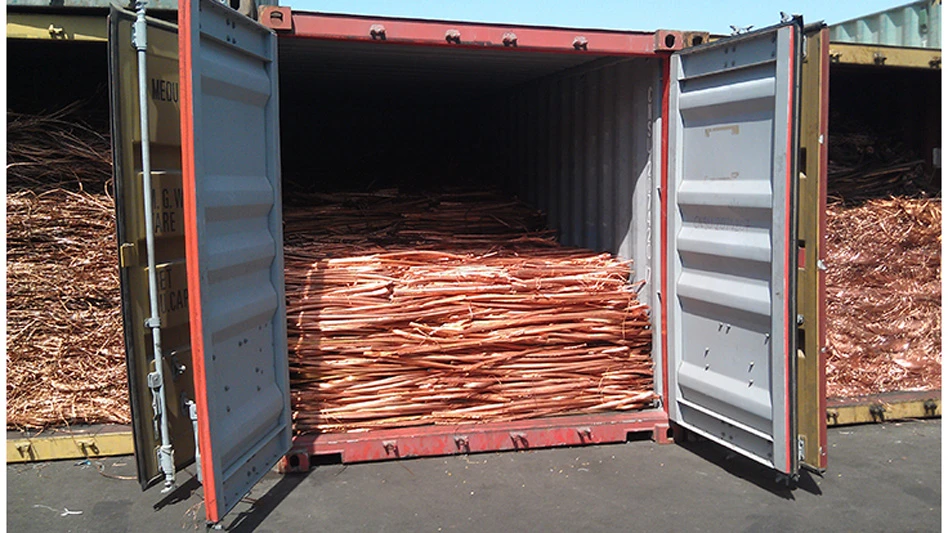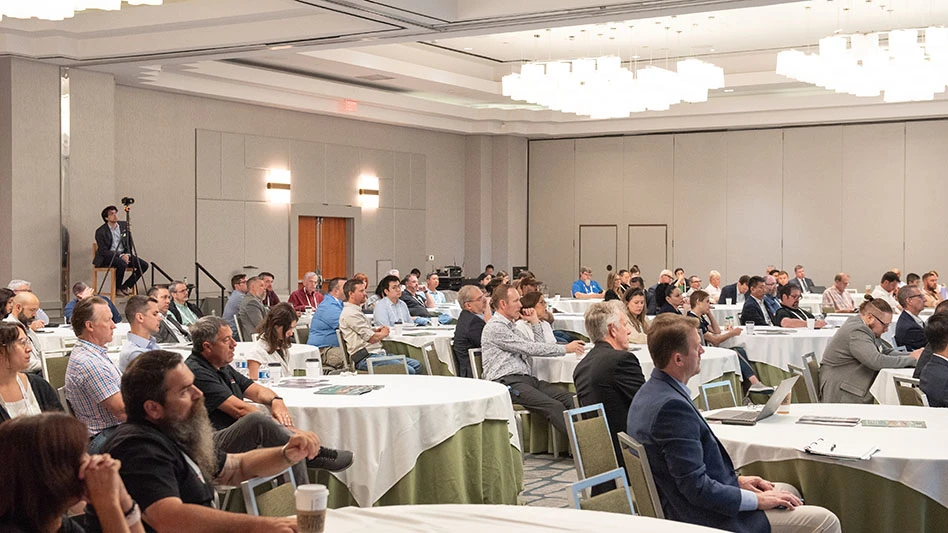Scrap processing began as a very low-tech, labor-intensive operation, and gradually evolved to the much more high-tech business it is today. Modern yards are safer and cleaner, and processing machines are easier to operate so there is much less chance of injury. The scrap equipment industry has also become increasingly competitive. For example, at one time there were only two manufacturers for balers, and now there more than a dozen. The same is true for scrap handlers. Even better, equipment companies are now designing machines with scrap processors in mind.
In the early days, much of the processing was done by hand, and it was back breaking work. But scrap processors came up with creative ways of moving material. Before the days of forklifts, cranes and electromagnets, ferrous processors might load scrap into a wheelbarrow on an incline, and then dump it into a railcar situated down below. Paper processors report the use of handcarts to move even 1,500-pound bales.
Early processing equipment, while much more effective than doing everything by hand, could be cumbersome. The earliest balers, often adapted from agricultural uses, compressed material using screws or platforms moved by manpower.
The baler continued to improve over the years, and some early designs have proven remarkably long-lived. For example, the only known continuous mechanical baler, the AMBACO Model 25-A, was installed sometime after World War II and operated continuously until the summer of 1995 at R.R. Donnelley & Sons’ Calumet plant in Chicago. The Smithsonian Museum, Washington, wanted to acquire it, but the machine’s massive size (30 feet long) and weight (10 tons) made that impossible.
STEADY PROGRESSION
Scrap processing of one form or another has been going on for hundreds of years. Burning is one method often used to separate materials or to make it easier to break large equipment such as ships into smaller pieces. Hammers, axes, chisels, crowbars, sledgehammers, and improvised drop ball breakers were other early tools, all requiring a great deal of physical labor to use.
In the late 19th century, the first mechanical tools for scrap processing, such as shears, balers and cutting torches, came into existence. In the early part of the 20th century, electromagnets were invented. Around the same time, electrically driven alligator shears came into use. These were faster than vertical shears but were more dangerous, opening and closing continuously. Also, the operator had to hold the scrap while it was being cut, resulting in some lost hands and fingers. Today’s hydraulic alligator shears have clamps to hold scrap, along with foot pedals to control the operation of the machines. For processing large volumes, there are now hydraulic guillotine shears.
After World War II, low speed, shear type shredders came into use for shredding smaller materials, such as tires and pallets. These were an alternative to hammermills.
Then in the 1950s and 1960s, there were big developments for processing used automobiles, which were formerly burned to get rid of contaminants such as plastics and foam, and then taken apart with cutting torches. Al-jon Inc., Ottumwa, Iowa, made a car crusher; and Proler Steel, Houston; Luria Bros., Cleveland; and Newell Industries, San Antonio, Texas, developed huge shredders for cars.
These developments were motivated largely by changes in federal regulations that no longer allowed processors to burn cars. In addition, there were about 14 million abandoned cars in the U.S. at that time, so Ladybird Johnson supported a national campaign to clean these up. Automobile shredders have continued to develop, with today’s shredders resembling complete factories.
Shears attached to cranes were invented in the 1970s by LaBounty Manufacturing, Two Harbors, Minn., for taking apart large items such as buildings and airplanes.
MUCH SAFER
Today’s scrap processing operations are much safer than those in the 1950s, according to Peter Avagliano, vice president of Schiavone-Bonomo Corp., Jersey City, N.J.
"I’ve been here since 1950, when the major piece of equipment to prepare steel was the alligator shear, which was a rather dangerous operation," says Avagliano. "It’s up and down, and you put the piece underneath there by hand, and if you had a piece of hard steel, it would just jump back at you. People were losing eyes and fingers. Now you have the hydraulic shear, which anybody can operate."
There were also sometimes accidents with the cutting torches that were used to take apart automobiles, he says. "Now they go into a shredder, so nobody’s around it. A shredder can take a car apart in a minute."
Another scrap processor who became active in the business in the 1950s says the main difference between operations then and today is that open burning of automobiles was a common part of scrap operations then. Environmental concerns were not really a part of the picture, and certainly were not the overriding concern they are today.
"Most of the shearing at that time was done by an alligator shear, which sometimes caused hand and finger injuries," he says. "That was an era when there were no guillotine shears and no shredders. There were balers and, of course, magnets and cranes, and the turning crusher was part of the business, but not a shredder."
Development of the shredder was partly motivated when burning of automobiles was no longer allowed, he says. "People were making an ‘unburned’ No. 2 bundle of the car, and as we now know, some 25 to 30 percent of the weight of the car is nonmetallic, so that put a large glut on the market of bundles that weren’t that attractive to steelmakers. This was an incentive to make a machine that didn’t burn, but shredded mechanically and separated the trash so that you had something that was 98 percent or 99 percent pure metal."
Copper wire was also burned during that time to get rid of the plastic casing. This practice was stopped when wire began to be made with polyvinyl chloride, because when burned, PVC releases harmful gases. Wire strippers and shredders came into widespread use at that time.
"The generation before me remembered loading scrap by wheelbarrow, up a slight incline and down into the railroad car that was at a lower level, and that, of course, was back breaking work," says the processor. "The main change there was the introduction of the electric magnet in the late 1920s and early 1930s that allowed scrap to be lifted by other than hand labor."
There has been a progression in cranes, he adds. They started as crawler types, and then cranes that were able to move on railroad tracks were developed. These could switch cars as well as doing the loading and unloading. They were originally mechanical, with diesel engines, and then were upgraded to electric motors. Cable cranes evolved into hydraulic cranes, and pedestal cranes were developed for ship loading.
"We found, as an industry, that we were training all our people to run cable cranes, and then they’d go out to the construction industry and make twice what they were making in the scrap yard," says the processor. "That was an incentive to create what they now call hydraulic cranes, which are not nearly as complicated to operate."
ROTARY SHREDDERS
According to Vernon Birda, a Portland, Ore., lawyer formerly with Saturn Manufacturing (now MAC Corp./Saturn Shredders, Grand Prairie, Texas), his company popularized the use of the slow speed, shear type shredder in the U.S. in the 1970s, and developed larger models than the 20 horsepower models invented in Germany. Saturn’s shredders went up to 600 horsepower, according to Birda.
"We would shred everything from beer cans to refrigerators and stoves to garbage," he says. "We had transmission cases for General Motors, we had tires from Firestone and all the tire companies. The little ones for beer cans had quarter inch cutters, and the big ones would have cutters almost two inches wide to rip things apart."
Rather than crushing material with hammers, like the larger hammermill shredders, rotary shredders have two counter-rotating blades that cut materials. The rotary shredders are smaller, less expensive, and use less energy than hammermills, says Birda.
One problem with the early rotary shredders was the necessity of reversing the motor repeatedly to handle tough items without burning out the motor.
"We went to a hydraulic drive mechanism which we reversed just by flipping a switch, so the electric motor would keep pumping all the time in the same way, but there would be a little valve that would flip, then it would reverse for five seconds, then that valve would flip back the other way," Birda explains. "Meanwhile, it was going full speed so it wouldn’t have to start slowly and go wham and hit it again, and then we wouldn’t burn out any motors. That was the secret of our success."
BY HAND AND BY HORSE
The secondary paper processing industry has also come a long way since its early days, according to Tom Lyon, president of Vista Fibers, Dallas. His company used to operate an old paper processing plant in New Orleans, which had an associated building down the block called "The Stables", where the company stored its trucks.
"The name Stables came from the fact that it used to be where they kept the horses," says Lyon. "Where today we drive trucks around to pick up material, they actually had horses and buggies that went out and provided service to their suppliers."
Lyon has seen pictures of early manual balers that were used to compress paper. "It had a lever on the side with a board that stood out on the side, and it was fastened to the top platen," he explains. "After you put the material in, a person or two would stand on that platform and that would then pull down the top part of it, and that’s how they compressed paper."
There are still some Logemann pit balers in existence, he adds. To install these balers, it was necessary to dig a pit in the ground. "You dug a hole in the ground, and you pushed everything from floor level into that hole, and then it had a platen on the bottom of it, and it is then raised up and compressed against the top," says Lyon. "There was a hydraulic cylinder which went straight down in the ground underneath, and you used that hydraulic pressure to push the platen up, and it would compact against the top, and then you put wires around it."
There were also electric units which had big chains on each side, and as you drove them, the chain would pull the material up and compress it against the top, he adds. Later, the more familiar horizontal balers were developed.
"Balers keep developing to the point where some balers today are supposedly fully automatic and can be programmed so that you don’t even need a baler operator," says Lyon. "And you can simply throw a switch as to which type of grade you’re using and it will adjust accordingly. It’s a long way from 100 percent manual."
Vista’s Dallas plant still has a couple of old wooden slat conveyors, which are usually not seen anymore. "That was the first heavy-duty conveying of any consequence, and then of course they went to the Mayfran," he says. "By the late 1960s, everybody was putting in the steel frames."
Before the invention of the forklift truck, paper bales were moved with a two-hand cart. These had two prongs that stuck out in front which were driven into the bottom of the bale, and then the bale was leaned back on the cart and rolled from place to place. People were somehow able to move 1,500-pound bales with these carts, says Lyon.
"I once saw a demonstration of the way they used to load railcars," he says. "You would take a bale in on these carts, and lay the first one down horizontally. Then when the second one came in you could flop it over on top of that one. Now if you wanted to go three high, they put one horizontally in front of that one and they could sort of pivot it, roll it up. And they could literally stack material to the height of the railcar."
Again, although they were able to load the railcars, it was a very labor intensive operation, requiring not just one man but three or four strong men to manage. "They’d have three or four husky men to do it, but they literally could load railcars that way, with no forklifts or anything else," says Lyon.
CRUSHING CARS
The scrap business has changed a lot in the 30 of so years he has been involved, says Jon Kneen, chief executive officer of Al-jon Inc., Ottumwa, Iowa. "In the 1960s, most companies were smaller and were family-owned," he says. "They were just starting to look for equipment to help them better process materials."
Kneen says it is exciting to be a part of that development. "In the early 1970s, for many companies, a car crusher or baler was the first piece of real equipment they ever bought, and it changed their operations. They had to hire new people and train them to use it, and they were able to process much more material."
The car crusher had its beginnings in the early- to mid-1960s when cars could no longer be burned, and people were looking for more efficient ways to crush cars so that more could be transported at one time. "People used to drop heavy steel plates on cars to crush them, or run Army tanks over them," says Kneen. "One of our customers suggested we build a car squeezer, so we decided to try it."
The car crusher enabled processors to fit 10 to 12 crushed cars in a rolloff container rather than only two. "We had to figure out the pounds per force to crush cars, and figure out how to make them the right size to put in rolloffs," he says. "We came up with the concept of a mechanical device to crush a car in a series of steps to make it consistent."
Al-jon patented the machine, and went on to sell a large number of car crushers. Today the machine is very sophisticated, completely automated by an on-board computer, and it is standard equipment for most auto dismantlers, who then sell the crushed cars to shredding operations. Kneen estimates there are now at least 10,000 car crushers in the U.S. But more changes are in the works as the composition of cars changes.
"We crush cars that are seven to nine years old," he says, "so in seven to nine years from now we’ll be looking at crushing cars with aluminum hoods, plastic bumpers, computers – it’s an ongoing process."
STILL A LONG WAY TO GO
Ben Sacco, chief executive officer of Sierra Iron & Metal and Sierra International Machinery, Bakersfield, Calif., is very interested in the evolution of scrap processing methods. His company developed the shear/baler.
"Ten years ago people were skeptical when we came up with the shear/baler concept, but it’s more versatile and efficient,"he says. "The LaBounty type shear is a good shear for preparation, not for production. It’s a beautiful tool, but the shear/baler gave the industry a new horizon and enabled them to do more."
It’s important to find the most progressive ways to process materials, says Sacco. "Some people are resistant to change. I once tried to sell a man a baler that would do in an hour what his five balers do in a week. It would have paid for itself in 8 months, but he wasn’t interested."
However, these sorts of attitudes are starting to change, he says. "People are starting to buy new equipment. A lot has to do with the younger generation coming in."
The changes that have taken place in the U.S. are very easy to see when you look at processing in developing countries, says Sacco, where cars are still being cut with an ax and chisel.
However, other parts of the world are more advanced than the U.S. in some ways, he adds. "In Italy every truck peddler has a crane, and 90 percent of the yards are paved. Here, too often, they still load by hand. There has been a lot of progress, but there is still a long way to go."
The author is former editor of Recycling Today.

Explore the June 1997 Issue
Check out more from this issue and find your next story to read.
Latest from Recycling Today
- APR, RecyClass release partnership progress report
- Clearpoint Recycling, Enviroo sign PET supply contract
- Invista expanding ISCC Plus certification program
- Redwood partnership targets recycling of medium-format batteries
- Enfinite forms Hazardous & Specialty Waste Management Council
- Combined DRS, EPR legislation introduced in Rhode Island
- Eureka Recycling starts up newly upgraded MRF
- Reconomy Close the Gap campaign highlights need for circularity





